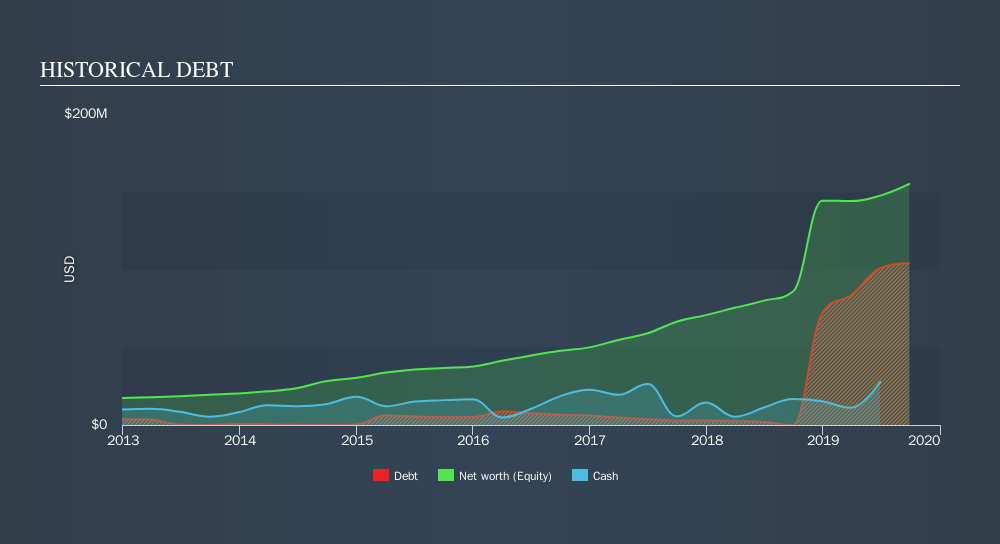- United States
- /
- Professional Services
- /
- NasdaqGM:WLDN
These 4 Measures Indicate That Willdan Group (NASDAQ:WLDN) Is Using Debt Extensively

Legendary fund manager Li Lu (who Charlie Munger backed) once said, 'The biggest investment risk is not the volatility of prices, but whether you will suffer a permanent loss of capital. It's only natural to consider a company's balance sheet when you examine how risky it is, since debt is often involved when a business collapses. As with many other companies Willdan Group, Inc. (NASDAQ:WLDN) makes use of debt. But the more important question is: how much risk is that debt creating?
Why Does Debt Bring Risk?
Debt is a tool to help businesses grow, but if a business is incapable of paying off its lenders, then it exists at their mercy. Ultimately, if the company can't fulfill its legal obligations to repay debt, shareholders could walk away with nothing. However, a more common (but still painful) scenario is that it has to raise new equity capital at a low price, thus permanently diluting shareholders. Of course, plenty of companies use debt to fund growth, without any negative consequences. The first thing to do when considering how much debt a business uses is to look at its cash and debt together.
See our latest analysis for Willdan Group
What Is Willdan Group's Debt?
You can click the graphic below for the historical numbers, but it shows that as of September 2019 Willdan Group had US$103.9m of debt, an increase on US$409.0k, over one year. However, because it has a cash reserve of US$27.6m, its net debt is less, at about US$76.3m.

How Healthy Is Willdan Group's Balance Sheet?
According to the last reported balance sheet, Willdan Group had liabilities of US$100.6m due within 12 months, and liabilities of US$106.9m due beyond 12 months. Offsetting this, it had US$27.6m in cash and US$143.6m in receivables that were due within 12 months. So it has liabilities totalling US$36.4m more than its cash and near-term receivables, combined.
Since publicly traded Willdan Group shares are worth a total of US$306.7m, it seems unlikely that this level of liabilities would be a major threat. But there are sufficient liabilities that we would certainly recommend shareholders continue to monitor the balance sheet, going forward.
We use two main ratios to inform us about debt levels relative to earnings. The first is net debt divided by earnings before interest, tax, depreciation, and amortization (EBITDA), while the second is how many times its earnings before interest and tax (EBIT) covers its interest expense (or its interest cover, for short). Thus we consider debt relative to earnings both with and without depreciation and amortization expenses.
While Willdan Group's debt to EBITDA ratio (3.4) suggests that it uses some debt, its interest cover is very weak, at 1.8, suggesting high leverage. It seems that the business incurs large depreciation and amortisation charges, so maybe its debt load is heavier than it would first appear, since EBITDA is arguably a generous measure of earnings. So shareholders should probably be aware that interest expenses appear to have really impacted the business lately. Worse, Willdan Group's EBIT was down 46% over the last year. If earnings keep going like that over the long term, it has a snowball's chance in hell of paying off that debt. The balance sheet is clearly the area to focus on when you are analysing debt. But ultimately the future profitability of the business will decide if Willdan Group can strengthen its balance sheet over time. So if you want to see what the professionals think, you might find this free report on analyst profit forecasts to be interesting.
But our final consideration is also important, because a company cannot pay debt with paper profits; it needs cold hard cash. So the logical step is to look at the proportion of that EBIT that is matched by actual free cash flow. Over the most recent three years, Willdan Group recorded free cash flow worth 61% of its EBIT, which is around normal, given free cash flow excludes interest and tax. This cold hard cash means it can reduce its debt when it wants to.
Our View
Both Willdan Group's EBIT growth rate and its interest cover were discouraging. But its not so bad at converting EBIT to free cash flow. Taking the abovementioned factors together we do think Willdan Group's debt poses some risks to the business. So while that leverage does boost returns on equity, we wouldn't really want to see it increase from here. Over time, share prices tend to follow earnings per share, so if you're interested in Willdan Group, you may well want to click here to check an interactive graph of its earnings per share history.
Of course, if you're the type of investor who prefers buying stocks without the burden of debt, then don't hesitate to discover our exclusive list of net cash growth stocks, today.
We aim to bring you long-term focused research analysis driven by fundamental data. Note that our analysis may not factor in the latest price-sensitive company announcements or qualitative material.
If you spot an error that warrants correction, please contact the editor at editorial-team@simplywallst.com. This article by Simply Wall St is general in nature. It does not constitute a recommendation to buy or sell any stock, and does not take account of your objectives, or your financial situation. Simply Wall St has no position in the stocks mentioned. Thank you for reading.
About NasdaqGM:WLDN
Willdan Group
Provides professional, technical, and consulting services primarily in the United States.
Flawless balance sheet with solid track record.
Similar Companies
Market Insights
Community Narratives




